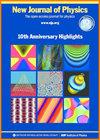分解减弱薄层磁化的不同界面效应
IF 2.8
2区 物理与天体物理
Q2 PHYSICS, MULTIDISCIPLINARY
引用次数: 0
摘要
在磁学和自旋电子学领域,厚度从几个原子单层到几个纳米不等的薄埋磁层无处不在。要实现使用此类磁层构建的设备的功能和微调,就必须准确了解与深度相关的磁性能。界面磁特性尤其重要。因此,了解磁性如何受到厚度或界面粗糙度等结构变化的影响至关重要。在这项研究中,我们使用 X 射线共振磁反射仪和磁力仪研究了夹在氧化物和铬层之间的磁性过渡金属薄层的高分辨率深度磁化曲线。与块状材料相比,这些层的室温饱和磁化率降低了高达 67%。这些降低对微小的结构变化极为敏感。从磁性深度剖面图中,我们可以分辨出导致磁化降低的不同效应以及界面的确切磁性。本文章由计算机程序翻译,如有差异,请以英文原文为准。
Disentangling different interfacial effects of reduced thin layer magnetizations
Thin buried magnetic layers ranging from thicknesses of a few atomic monolayers to several nanometers are omnipresent in the fields of magnetism and spintronics. For the functionality and fine tuning of devices build with such layers, exact knowledge of the depth dependent magnetic properties is essential. Especially the interfacial magnetic properties are important. Hence, understanding how magnetism is affected by structural variations, such as thickness or interface roughness, is mandatory. In this study, we use x-ray resonant magnetic reflectometry and magnetometry to study the high-resolution depth dependent magnetization profiles of thin magnetic transition metal layers sandwiched between an oxide and chromium layer. Compared to bulk materials, the room temperature saturation magnetization of these layers is reduced by up to 67%. These reductions are extremely sensitive to small structural variations. From the magnetic depth profiles, we disentangle different effects contributing to the magnetization reduction and the exact magnetic properties of the interface.
求助全文
通过发布文献求助,成功后即可免费获取论文全文。
去求助
来源期刊

New Journal of Physics
物理-物理:综合
CiteScore
6.20
自引率
3.00%
发文量
504
审稿时长
3.1 months
期刊介绍:
New Journal of Physics publishes across the whole of physics, encompassing pure, applied, theoretical and experimental research, as well as interdisciplinary topics where physics forms the central theme. All content is permanently free to read and the journal is funded by an article publication charge.
 求助内容:
求助内容: 应助结果提醒方式:
应助结果提醒方式:


